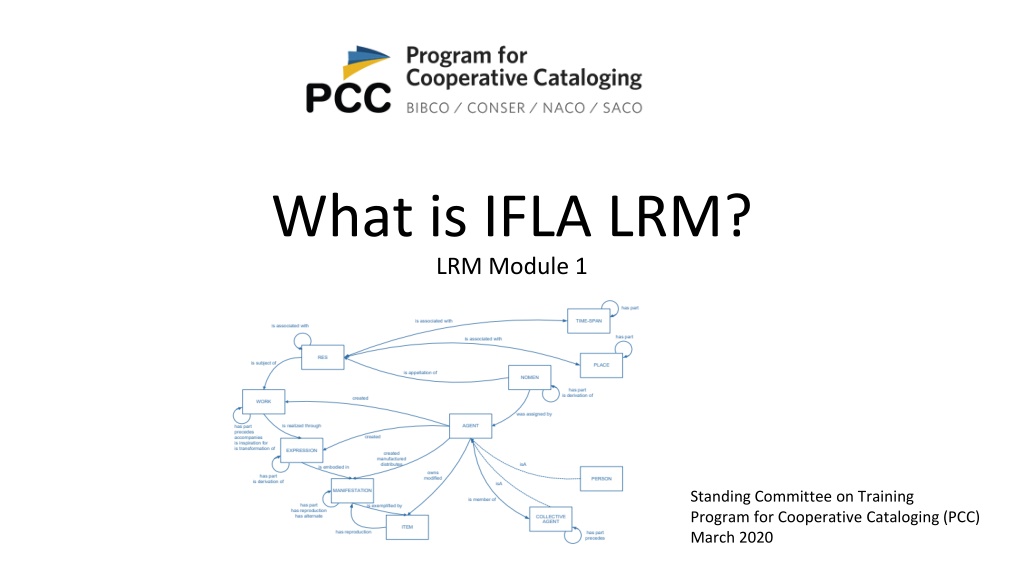Understanding IFLA LRM: A Conceptual Reference Model
IFLA LRM, created by the International Federation of Library Associations and Institutions, consolidates FRBR, FRAD, and FRSAD models into a coherent framework. It aims to structure bibliographic data logically and inclusively, focusing on end-user needs and tasks. The model describes interrelated entities in various domains of knowledge, emphasizing relationships and attributes. Learn about the principles and predecessors of IFLA LRM to enhance your understanding of this high-level conceptual reference model.
Download Presentation

Please find below an Image/Link to download the presentation.
The content on the website is provided AS IS for your information and personal use only. It may not be sold, licensed, or shared on other websites without obtaining consent from the author. Download presentation by click this link. If you encounter any issues during the download, it is possible that the publisher has removed the file from their server.
E N D
Presentation Transcript
What is IFLA LRM? LRM Module 1 Standing Committee on Training Program for Cooperative Cataloging (PCC) March 2020
Learning Outcomes By the end of this module, you will be able to: Identify the predecessors of LRM Understand what LRM is Understand the concept of an entity-relationship model Identify the (end)-user tasks associated with LRM Understand how LRM can be used 2
The Acronyms IFLA International Federation of Library Associations and Institutions LRM Library Reference Model a high-level conceptual reference model developed within an entity- relationship modelling framework. It is the consolidation of the separately developed IFLA conceptual models: FRBR, FRAD, FRSAD 3
IFLA LRM Predecessors Functional Requirements for Bibliographic Records (FRBR): is a conceptual entity-relationship model of metadata developed by IFLA for information objects. Published in 1998 by IFLA Functional Requirements for Authority Data (FRAD): defines functional requirements of authority records. FRAD was developed as an extension and expansion of FRBR. Approved 2009 by IFLA Functional Requirements for Subject Authority Data (FRSAD): conceptual entity-relationship model and a continuation of the work based upon the FRBR model. The main focus is how: ... entities that serve as subject of intellectual or artistic endeavor can be related and controlled within the bibliographic universe. Approved 2010 IFLA Library Reference Model (LRM) combines and consolidates the FR family into a single coherent model 4
What are the principles of IFLA LRM? A high-level conceptual reference model developed with an enhanced entity- relationship modelling framework (see Slides 6-7), covering bibliographic data in a broad, general sense Aims to make explicit general principles governing the logical structure of bibliographic information, without making presuppositions about how that data might be stored in any particular system or application does not make a distinction between data traditionally held separately as bibliographic, authority, or holdings data; includes it all Takes its functional scope from the user tasks, defined from the point-of-view of the end-user and the end-user s needs (see Slide 8) 5
The Entity-Relationship Model Describes interrelated things of interest in a specific domain of knowledge Composed of: Entities classify things of interest Relationships relationships that can exist between entities PERSON (entity) WORK (entity) WROTE Attributes further describe an entity or relationship in some way Category: Novel Representative Expression attribute: English WORK (entity) 6
The Enhanced Entity-Relationship Model Entity-relationship model that incorporates the notion of inheritance of attributes and relationships from an entity to all the entities that are subsumed in it AGENT Example: A Person is a subclass of an Agent. It thus inherits the attributes and relationships of the Agent class, while also having its own unique attributes and properties Is a subclass of PERSON 7
(End-)User Tasks as Defined in LRM To bring together information about one or more resources of interest by searching on any relevant criteria Find: To clearly understand the nature of the resources found and to distinguish between similar resources Identify: To determine the suitability of the resources found, and to be enabled to either accept or reject specific resources Select: To access the content of the resource Obtain: To discover resources using the relationships between them and thus place the resources in a context Explore: 8
How is IFLA LRM used? In PCC, our metadata practices are built on 4 pillars: Current Next? Future?* Conceptual models Cataloging Codes Communication Formats / Encoding Standards Application profiles (APs) Data Model FRBR LRM LRM Cataloging Code RDA RDA (Beta) RDA (Beta) Communication Format MARC MARC RDF App. Profile LC-PCC PS / BSR LC-PCC PS / BSR / other? Formal AP? LRM is intended as a guide or basis on which to formulate cataloging rules and implement bibliographic system The new version of RDA is a set of cataloging guidelines based on LRM * Only one possible future scenario! There are more 9
Practical Applications Requirements Practical applications will need to determine the appropriate level of precision, requiring either expansion within the context of the model, or possibly some omissions Requires some sort of application profile to implement, which would state: Level of precision Expansions, omissions Choices, interpretations Adaptation to communication format used 10
Summary IFLA LRM is a high-level conceptual reference model developed with an enhanced entity-relationship modelling framework covering bibliographic data is built on an entity-relationship model that incorporates the notion of inheritance of attributes and relationships from an entity to all the entities that are subsumed in it aims to make explicit general principles governing the logical structure of bibliographic information, without making presuppositions about how that data might be stored in any particular system or application Bases its functional scope based on user tasks Find, Identify, Select, Obtain, Explore is intended as a guide or basis on which to formulate cataloging rules and implement bibliographic system 11























